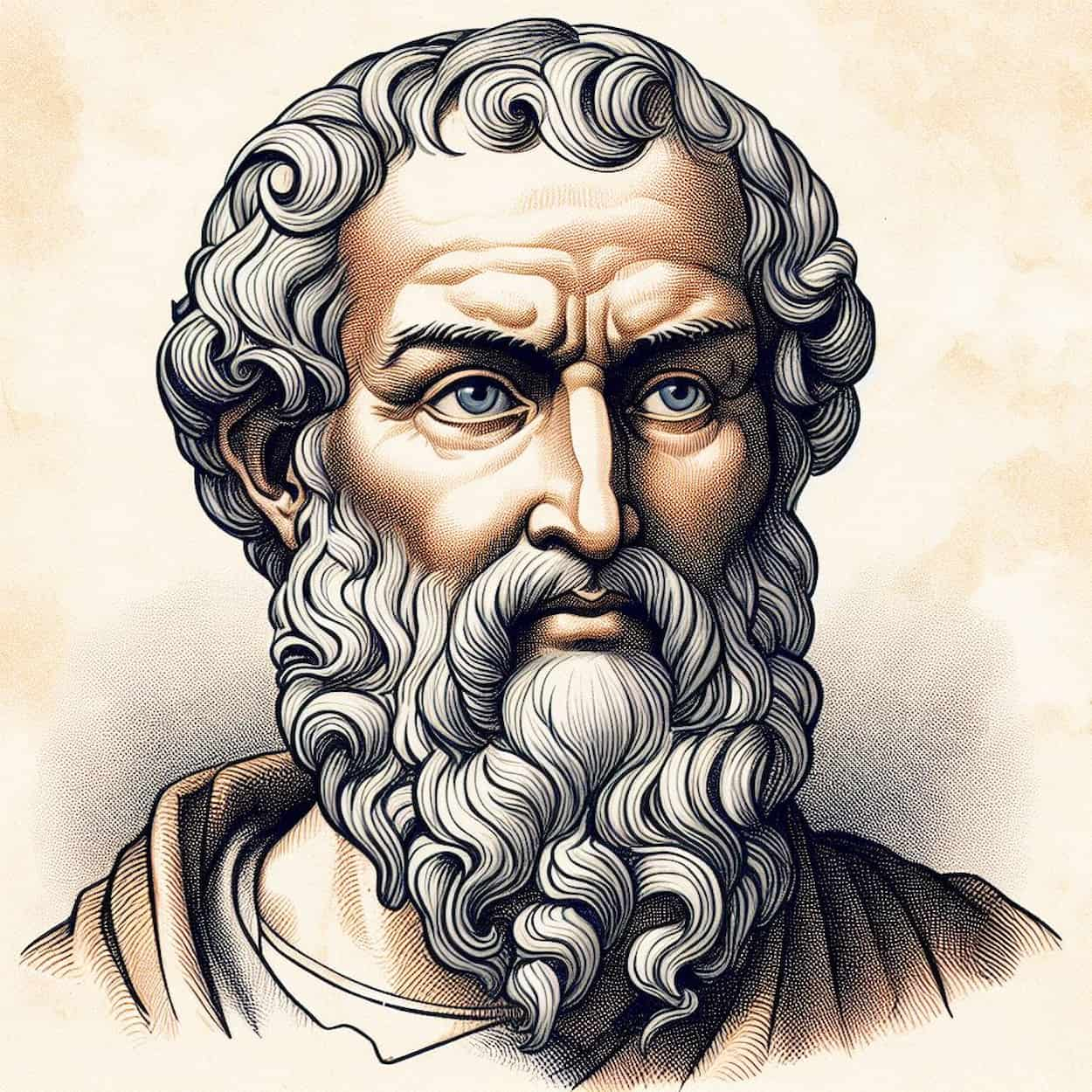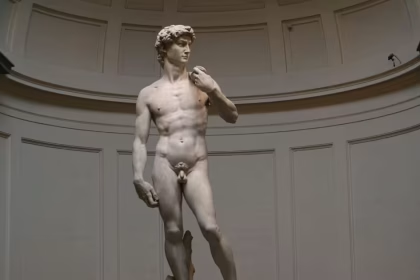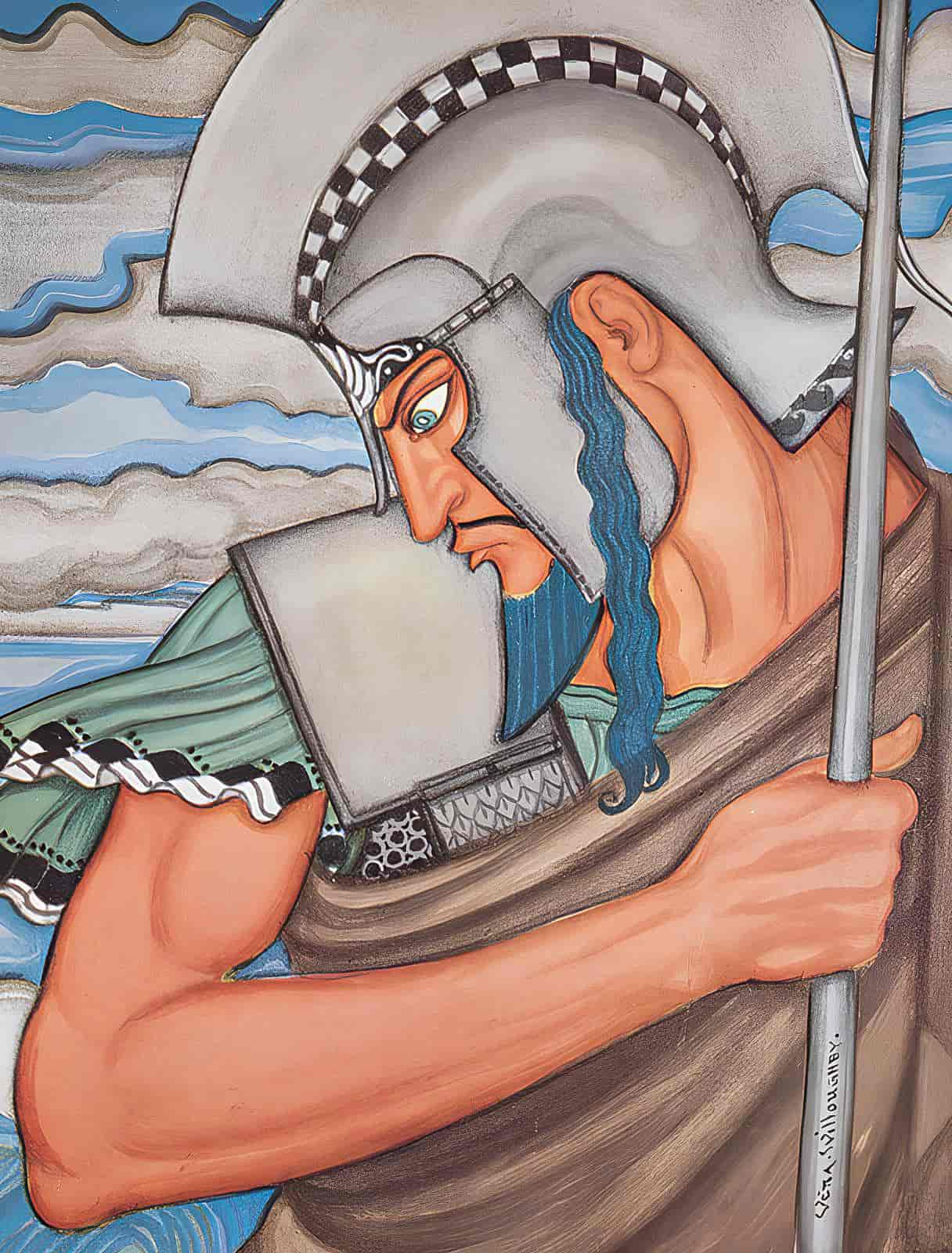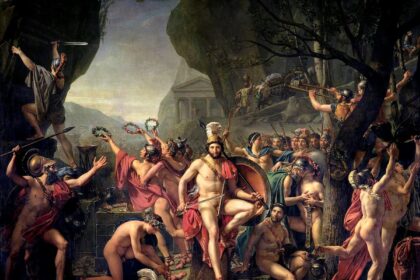Proclus Diadochus (Ancient Greek: Πρόκλος ὁ Διάδοχος, Latin: Proclus; February 8, 412, New Rome – April 17, 485, Athens) was an ancient philosopher-neoplatonist, the head of the Platonic Academy, during which neoplatonism reached its culmination.
An Overview of His Life
Proclus’ lifetime is reconstructed from sources as approximately 410–485 AD. His biographer, Marin, provides his horoscope, and based on astronomical data, Proclus’s birthdate is determined as February 8, 412 AD.
Proclus was born in the capital of the Roman Empire, Constantinople, into a wealthy family with a lawyer father from Xanthos. Intending to follow in his father’s footsteps, as a teenager, he traveled to Alexandria, where he initially studied rhetoric and later became interested in philosophy, becoming a disciple of the Alexandrian neoplatonist Olympiodorus the Elder. Under Olympiodorus, Proclus began studying Aristotle’s logical treatises, achieving success at that time, as reported by Marin.
At the age of 20, Proclus moved to Athens, where Plutarch of Athens was leading the Platonic Academy. Plutarch, despite his advanced age, personally engaged with Proclus, studying Aristotle’s “On the Soul” and Plato’s “Phaedo” with him. After two years, Plutarch passed away, handing over the leadership of the school to his student Syrianus, under whom Proclus continued his education.
Marin reports that by the age of 28, Proclus had written one of his major works, a commentary on Plato’s “Timaeus.” Around 450 AD, after Syrianus’s death, Proclus became the scholarch of the Platonic Academy.
Proclus lived during the decline of ancient Greek civilization. Pagan cults were waning due to the rise of Christianity. During this time, the famous statue of Athena by Phidias was removed from the Parthenon, an act perceived as sacrilege by Proclus. In a polemic with Christians, Proclus actively participated, reportedly writing “Arguments Against Christians” in 18 books (the work did not survive). At some point, the conflict between Christians and academics became so intense that Proclus was forced to leave Athens for Lydia for a year.
During his journey through Asia, Proclus encountered some Eastern teachings, which he synthesized into his own system. Religious practices, sun prayers, rituals, and orphic and Chaldean purifications became integral to the educational process at the Academy. Marin notes that Proclus spent “days and nights” in prayer, orphic and Chaldean purifications, and the performance of “various other religious rites.”
In his personal life, Proclus adhered to ascetic principles: he remained unmarried, abstained from meat, and observed fasting according to the guidance of gods revealed in his dreams. According to Marin, excessive asceticism contributed to his relatively early death: “His flourishing body withered from coarse and unbearable food, frequent ablutions, and similar discomforts.” Proclus was not a stranger to public activities; he participated in city assemblies.
He passed away in Athens at the age of 73, leaving Marin as his successor. He was buried in Athens in the same tomb as his teacher, Syrianus.
Works
Proclus’ major philosophical works focus on the consideration of the highest principles of existence and the affirmation of neoplatonism as a theological doctrine. In the treatise “Elements of Theology” (Στοιχείωσις θεολογική), Proclus presents the doctrine of suprasensible principles. The treatise consists of 211 paragraphs, each formulating and then asserting a certain proof.
“Platonic Theology” (Περὶ τῆς κατὰ Πλάτωνα θεολογίας) is a comprehensive work in which Proclus develops the doctrine of the highest principles and gods, citing numerous quotations from Plato to confirm that such a system already existed in Plato’s own teachings and that all of Plato’s works represent a unified sacred text.
Among the numerous commentaries by Proclus on Plato’s dialogues, only five have survived: “Timaeus” (Marin notes that Proclus valued this commentary above all others), “Parmenides,” “The Republic,” “Alcibiades I,” and partially “Cratylus.” Commentaries on “Philebus,” “Theaetetus,” “Sophist,” and “Phaedo” are entirely lost. A part of Proclus’ commentary on Plotinus’ “Enneads” has also survived. All commentaries on Aristotle are lost, but it is known that Proclus interpreted “Categories,” “On Interpretation,” and the First and Second Analytics.
Three small philosophical treatises by Proclus — “On Ten Doubts Concerning Providence,” “On Providence, Fate, and That Which Is Within Us,” and “On the Substances of Evil” — have survived only in the Latin translation by William of Moerbeke (13th century).
In the brief treatise “Elements of Physics” (Στοιχείωσις φυσική), a series of definitions and theorems present Aristotle’s physical system.
His astronomical works include a short treatise of elementary content called “Sphere” (Σφαῖρα), a concise “Outline of Astronomical Hypotheses” (Ὑποτύπωσις ἀστρονομικῶν ὑποθέσεων), a “Retelling of Ptolemy’s ‘Tetrabiblos'” and the book “On Eclipses,” preserved only in Latin translation.
Among Proclus’ mathematical works, the “Commentary on Book I of Euclid’s ‘Elements'” has been entirely preserved. Additionally, Proclus wrote a separate work on parallel lines, which has not survived.
From his religious and magical writings, “Eclogues from Chaldean Philosophy” (Ἐκ τῆς αὐτῆς Χαλδαϊκῆς φιλοσοφίας) and the book “On the Hieratic Art of the Greeks” (Περὶ τῆς καθ’ Ἕλληνας ἱερατικῆς τέχνης) have come down to us. Seven hymns to the gods have also survived: to Helios, Aphrodite, the Muses, all the gods, the Lycian Aphrodite, Hecate and Janus, and the wise Athena. These hymns, written in Homeric hexameter, draw attention to orphic content, calling on the gods to “help us avoid the black evil of births.” Such is the hymn addressed to the Muses.
We praise the light, uplifting the sorrow of mortals, singing
The nine daughters of the great Zeus with beautiful voices!
The souls of people, having filled their lives, plunge into the depths,
They can deliver from sorrows inherent to the earthly realm,
By the power of pure mystery, awakening the mind with a magical book,
They teach us how to swiftly traverse through the deep Lethe,
Finding the path leading to a star of the same name — for once,
They deviated from it and fell onto the shore of births
In a mad thirst to experience the fate of material life.
Now, goddesses, I implore you — calm my anxious impulse!
Intoxicate me with meaningful tales of the wise!
May the godless human race not derail me from the path,
From the wondrous, sacred path, radiant and full of fruits!
Muses, I pray — from the multitude of the sinful human race,
Eternally draw the wandering soul towards the sacred light!
Let the honey of your words weigh upon her, strengthening reason,
The soul whose glory lies in the enchanting virtue of the mind.
Proclus’ known works that have not survived include:
- “Arguments Against Christians” (Ἐπιχειρήματα κατὰ χριστιανῶν) in 18 books,
- “On Chrestomathy” (Περὶ χρηστομαθείας) in 2 books,
- “On Education” (Περὶ ἀγωγῆς) in 2 books,
- “On the Gods in Homer” (Περὶ τῶν παρ’ Ὁμήρῳ θεῶν),
- “On the Theology of Orpheus” (Εἰς τὴν Ὀρφέως θεολογίαν),
- “Harmony of Orpheus, Pythagoras, and Plato with the Oracles” (Συμφωνία Ὀρφέως, Πυθαγόρου, Πλάτωνος περὶ τὰ λόγια) in 10 books,
- “On the Great Mother” (Μητρῳακόν),
- “Commentaries on the Whole of Homer,”
- “Commentaries on Hesiod’s ‘Works and Days.'”
Teaching on Being
To overview Proclus’ philosophy, it is expedient to turn to his “Elements of Theology” since this treatise succinctly presents the system of neoplatonism in general.
The hierarchy of the Universe, according to Proclus, is constructed based on the scheme of Plato’s “Parmenides”: the supra-being One (also known as the Good and God); next are the henads – supra-being units or gods to whom existing gods, or intellects, are related, representing the intellectual Being that synthetically unites the principles of limit and the limitless.
Being and the intelligible gods are opposed to Mind (Nous) and thinking gods, linked to intellective gods through intellective-thinking gods. The supra-cosmic gods and thinking souls are connected to the intellective gods. The next level is the Cosmic Soul, distinguishing within it: intra-cosmic gods, universal souls, demonic “simple souls”: angels, demons in their own sense, and heroes.
Further down are “partial souls” that animate bodies, including the human soul. At the lowest level, there are inanimate bodies.
In this hierarchical structure, Proclus naturally includes traditional Olympic gods, organizing them into triads and classifying them as transcendent and cosmic. “Nature” mediates between bodies and souls, being bodiless but inseparable from the unconscious forces of bodies, identical to the force of fate. The lowest ontological level, though derived from the highest, is matter.
The treatise establishes the following “canonical” sequence:
- The One and the Many (in their statics, their transition, their organic fusion, resulting in actual infinity).
- Numbers or gods (provides the definition of numbers and the classification of gods, meaning Proclus’ teaching on supra-mental numbers is simultaneously a teaching on gods; each number Proclus calls a god).
- Mind (provides the definition of Mind and its limitation “from above and below”; establishes the self-identity difference of Mind and explores the hierarchy of Mind in relation to its universality).
- Soul (provides the definition of the soul, its properties, and types; describes the rotation and hierarchy of souls; determines the carrier of the soul).
- Cosmos (provides the definition of the Cosmos as the material realization of the three basic hypostases of neoplatonism).
The One is considered by Proclus as 1) being self-existent, without any multiplicity and before [any] multiplicity; then as 2) the One in which multiplicity has already originated, but in itself, it remains a simple and indivisible meaning of this multiplicity; and finally, as 3) the actual unity of the One and the Many, in which there is not only meaning but also the enumerability of all its components.
A possible key to understanding the One according to Proclus, as well as understanding Proclus’ philosophy in general, is the “Law of Triad”:
The Law of Triad, according to which every being is a limit, the limitless, and a mixture in different proportions of both, is valid not only for the highest hypostases but also for the soul, physical and mathematical objects—in short, for everything without exception… According to Proclus, all levels of reality, from the bodiless to the corporeal, are composed of two essential components: 1) the limit, peras, and the limitless, apeiron, or the infinite, which relates to both form and matter. Every being, as a consequence, is a “mixture,” a synthesis of the two components (this thesis, evidently, is borrowed by Proclus from Plato’s “Philebus” and his unwritten doctrines).
Following the One, Numbers, “supra-being units,” are examined. They are superior to being since they are the principle of being itself and its differentiation. They are also superior to thought because they are the principle of every division and union, without which thought cannot be realized. Number, thus, occupying the first place after the One, is a dissecting and uniting “creative force.”
Proclus’ development of the realm of Numbers, intermediate between the One and Mind, should be particularly emphasized. The clear delineation of the realm of Numbers is unique to Proclus.
Every abstract number, being incorporeal, surpasses every object and thing, in this respect entirely analogous to the One. It is also, being the principle of every differentiation and formation, entirely analogous to Mind. Thus, Numbers are intermediary entities between the incorporeal One and the qualitative Mind.
The realm of Mind begins with being as the first qualitative fulfillment of numbers. Then follows the domain of the energetic fulfillment of being itself, which Proclus calls life. Life, comparing itself with itself, gives us proper thought and knowledge. Thus, the realm of Mind is constituted by three stages—being, life, and knowledge.
Cosmic Soul (the third hypostasis of neoplatonism) is nothing else but the principle of the eternal becoming of the Cosmos. Just as for Proclus, the intellect is the unity of being and thinking, and the soul is the unity of intellect and corporeality.
The soul is invoked to explain the movement in the world, similar to how the intellect is invoked to explain the regularity of the soul’s actions. Accordingly, the intra-cosmic souls are the principles of the formation of individual bodies. Proclus speaks of different types of souls: divine souls, souls of the intellect, and souls of changeable entities. In general, for Proclus, the soul denotes the intermediate realm between the indivisible intellect and divisible bodies. He attributes to the soul properties such as incorporeality, immortality, reflection of all forms of intellect within itself, its connection with that eternal body for which it is the animating principle, and so on.
Proclus asserts the “rotation” of souls and their hierarchy. Here, too, there is the following paradox: the soul itself is incorporeal, and yet there must always exist its own body, the principle of animation of which it is. And since the soul is eternal, this body must also be eternal. Thus, according to Proclus, not only physical, perishable bodies exist but also soulful, intellectual, and divine bodies.
Finally, the Cosmos is nothing else but the material realization of the three fundamental hypostases of neoplatonism. Proclus paints a grand picture of the universal [circular] movement of the Universe. Since there is always a “return to itself” in this movement, an evolution, the Cosmos is “ageless,” eternal. The central position in it is held by the Sun – Helios, maintaining the cosmic equilibrium. Proclus’ mythological triad: Helios – Apollo, intelligent illuminating demiurgy; Athena, intelligent illuminating knowledge; Aphrodite, intelligent illuminating beauty.
From the point of view of logic proper, Proclus’ most remarkable development is the dialectic of Being. Proclus depicts in detail how Being transitions “from its supra-being and indivisible self-enclosure… into divisibly comprehensible otherness and then returns to itself in an enriched form.”
The main principle of concept development in Proclus is clear triadism. He also considers each member of the basic triad also triadically. This triad of categories, initiated by Plotinus, elaborated by Porphyry, and developed and completed by Proclus, is applicable to any process. Essentially, it has a universal methodological significance: 1) self-contained existence, indivisible unity (provoking emanation due to its completeness, emerging beyond this unity); emanation from itself (proper emanation, transition into multiplicity); return to itself (return to the initial wholeness, not canceling the meaning of the process of emanation; “state of the indivisible eidolon”).
An important category for Proclus is the concept of “participation.” It indicates the higher to which the lower adheres and by which it is understood; thus, this category signifies the reverse transition from the many to the One. Proclus distinguishes between that which does not admit participation, that which allows it, and that which properly participates.
Proclus’ theory of knowledge is linked to his ontology of a multilayered being. The clearest knowledge is ensured by theoretical contemplation, corresponding to intelligible entities, where existing objects are perceived directly and entirely. Scientific knowledge is lower in the hierarchy of cognitive methods because it combines reasoning with sensory perception.
Reasoning (διάνοια) uses concepts to determine things and verify the reports of sensory perception. Scientific knowledge is the result of the reasoning activity of the soul, which aligns concepts with opinions derived from sensory data. This is done according to positive criteria of truth, such as syllogistic proof and correspondence to being.
Ethics
At the center of Proclus’ ethics is the concept of “virtue”—as that which reunites us with the gods, bringing us closer to the One. In Proclus’ school, virtues were distinguished as natural, moral, social, and higher, including: purificatory, contemplative, and theistic virtues (the latter were considered superior to human destiny). Marin enumerated among natural virtues: the harmlessness of all external senses, bodily strength, beauty, and health; according to his testimony, Proclus possessed all these virtues in full, ascending to the theistic ones.
As for the problem of Evil, Proclus identifies its cause in canonical accordance with the understanding of evil established by Plotinus—evil arises from human aversion to the higher, intellect-perceived world, from attachment to the sensory and material. Hence, the task of humans is to turn away from the lower world and know the higher power of their soul. Proclus places this power above even the intellect, as, according to him, only it is capable of perceiving the first principle. Therefore, Proclus calls this power the “color of our essence” and “that one thing in the soul which is better even than intellect.” This power can be identified with mystical enthusiasm and sacred madness, leading us to merge with the Divine.
Physics
Proclus’ physics marks a radical departure from Aristotle’s position on two points: the elements of the physical world and the concept of place as space.
Proclus rejects the ether, Aristotle’s fifth element, as redundant. Celestial bodies consist of the same (four) elements as earthly ones. For example, without the element of fire, stars and the sun could not emit light, and without the element of earth, they could not be opaque (as during eclipses). Proclus distinguishes the celestial state from the terrestrial: in the former, the elements are in their highest degrees (for example, fire only illuminates, earth is purely material and impermeable); in the latter, they are “coarse” (for example, fire burns, earth is heavy).
Moreover, Proclus develops a new perspective regarding the primary properties of elements, deriving them from the size, shape, and ability of their particles to move.
According to Aristotle, the place occupied by a body is not its boundary. Proclus, on the other hand, posits that place is a kind of body, but without mass, which causes physical bodies to resist the presence of others. This is space. In a broad sense, there is cosmic space in which all bodies of the Universe are immersed. Space, separate from the bodies residing in it, resembles a body of light.
Philosophy of Mathematics
Proclus follows the traditional Platonic doctrine, according to which mathematical objects occupy a middle position between the world of ideas and the world of sensibly perceptible things. When proving a theorem, a geometer points to a drawn parallelogram, but in their mind, they conceive of a “parallelogram in general,” without specific proportions and dimensions. The theorem about the parallelogram deserves its name only when it is valid for all types of parallelograms.
Where do this type and all other mathematical types originate? In answering this question, Proclus engages in a debate with Aristotle, who believed that mathematical objects arise through the abstraction of the general from sensibly perceived objects and the assembly of this general into a unified definition. According to Aristotle, we first see and draw various sensibly perceived parallelograms and then give a general definition of a parallelogram—a quadrilateral with opposite sides equal and parallel. According to Plato, however, we can see in an imperfect figure like a parallelogram only because our soul already possesses knowledge of the parallelogram, and this knowledge is the ideal unity of definition-logos and image-eidos. Thus:
“It remains for the soul to generate mathematical types both from itself and from the intellect, and for it to be the completeness of types, although based on intelligent patterns, but self-generated by the lot that has befallen them. Therefore, the soul is not like a writing tablet free from inscriptions; it has been inscribed from eternity, writes itself, and is written by the intellect. For the soul is both intellect because it unfolds according to intellect and is the image of intellect and its external impression” (“Commentaries on Euclid,” 16.4—16.13).
According to Proclus, mathematical activity represents a peculiar kind of movement within the world of incorporeal logos. This movement occurs in two directions: on the one hand, it begins with external recollection and ends with the understanding of the principles of mathematical knowledge; on the other hand, it unfolds from these principles to the diversity of results. In mathematical cognition, one transitions from the known to the sought, and at other times, from the sought to the known. Proclus states:
“The cognitive abilities of this science, in general, turned out to be twofold, and one of them directs us towards unity and consolidates the multitude, while the others divide the simple into diverse, the more general into the more specific, and the initial logos into secondary and many steps removed from the initial. And so, starting from the top, mathematics reaches the sensibly perceptible, touches nature, and proves many things in conjunction with the teaching of nature. Similarly, starting from the bottom, it approaches intellectual knowledge and touches the contemplation of the first principles” (“Commentaries on Euclid,” 19.13—19.19).
A particularly interesting aspect is Proclus’ systematically developed doctrine of geometric matter. The subject of geometry is not sensible matter—it is impossible to find a line without width, a point without parts, a surface without thickness, or a circle with equal radii. But it cannot exist outside matter, in pure logos: geometric figures are multiple, divisible into parts, and they can be compared with each other as larger or smaller. So where does it exist?
Addressing this issue, Proclus follows Aristotle’s assertion that, in addition to sensible matter, there is also matter in imagination. It is precisely in this matter of imagination that the geometric forms with which the geometer deals are located.
“Imagination, being the center of knowledge, though stirred by itself and producing what is known, nevertheless, not being outside the body, transforms the known from indivisible life into divisible, extended, and shaped, and thus everything it conceives is an imprint and form of thought” (“Commentaries on Euclid,” 52.20—52.26).
The mental circle is one, for it exists only in definition, and the definition does not distinguish one circle from another, as all of them are circles. Imaginary circles can be many; we can imagine that such circles are concentric, touch each other, or are arranged in relation to each other in some other way. The mental circle is, in a sense, simple, non-extended, and without outlines, whereas extension, outlines, and divisibility characterize the circle with which we deal in imagination.
Astronomy
Proclus was well acquainted with both theoretical and observational astronomy. In his work “Outline of Astronomical Hypotheses,” he describes, among other things, the construction of the armillary sphere. He personally made some of the last reliable astronomical observations in antiquity (475 AD).
Proclus rejects Ptolemy’s interpretation of the precession of the equinoxes as the movement of all fixed stars. For Proclus, such stars cannot precess because it is inherent in their nature to be immovable. Proclus also denies that planets move on nested celestial spheres; the arguments for such a position are of a hypothetical nature and lack clear evidence, while celestial bodies are capable of moving in free space by their nature.
Evaluation
Proclus presents a qualitatively developed dialectic of being and myth, theology and theosophy, theurgy, as well as a unique aesthetics and ethics. Proclus’s ethical perspective is simultaneously cosmological; according to Proclus, one should consider humans exactly as “the entire cosmos because a human represents a small cosmos. Namely, they possess mind, logos, a divine and mortal body, similar to the Universe.”
Proclus is distinguished not so much by originality as by systematicity and detailed analytical thinking. Proclus’s philosophy is considered a “culmination” of ancient Neoplatonism, bringing it to its final “logical maturity.” A.F. Losev called Proclus the “genius of reason”; with reasoning brought “to music, to pathos, to ecstasy.” Losev even placed Proclus above the founder of the Platonic school, Plotinus, “in terms of the enormous analytical power of his mind, the great diversity of his interests in terms of the mastery of microscopic studies of the most abstract logical subject, and in terms of the subtlest philosophical-philological insight into Plato’s text.”
In this regard, the comparison of Plotinus and Proclus conducted by Yu. A. Shichalin is interesting: “What Plotinus saw in an ecstatic rush, Proclus reveals at the tip of the pen. Plotinus first discovered all the splendor of the universe and fully beheld the entire hierarchy of the One, Mind, Soul, and Cosmos. Proclus never saw the intelligible, but accurately described them, indicating their location between the level of the One and the Mind, as well as describing many intermediate steps between the other levels of the hierarchical structure.”
Arguably, the most remarkable assessment of Proclus is that this last great thinker of the ancient world, living in the era of its decline and demise, is seen by Marinus as the happiest of men. It is about “some kind of most perfect and complete happiness,” which consists not only of the happiness of the wise but also of life’s well-being.
“He was exceptionally attractive in appearance, not only due to his good constitution but also because his soul flourished in the body, like some vital light, emitting a marvelous radiance, difficult to depict in words… He was free from base concerns and any pettiness, disturbed only by the greatest and most common questions about the divine and human… He attached no importance to human life or death, as others do; everything that seemed terrifying to others did not inspire fear in him… He was entirely devoid of any aloofness, seclusion, or bias.”
With the name of Proclus, Professor A.F. Losev associates not only the mature completion of Neoplatonism but also the end of the tradition of the entire ancient philosophy.
Proclus’s philosophy enjoyed tremendous influence in the Middle Ages and the Renaissance. His direct followers can be considered Maximus the Confessor, Nicholas of Cusa, Pico della Mirandola, John Petreius, and others.
Memory
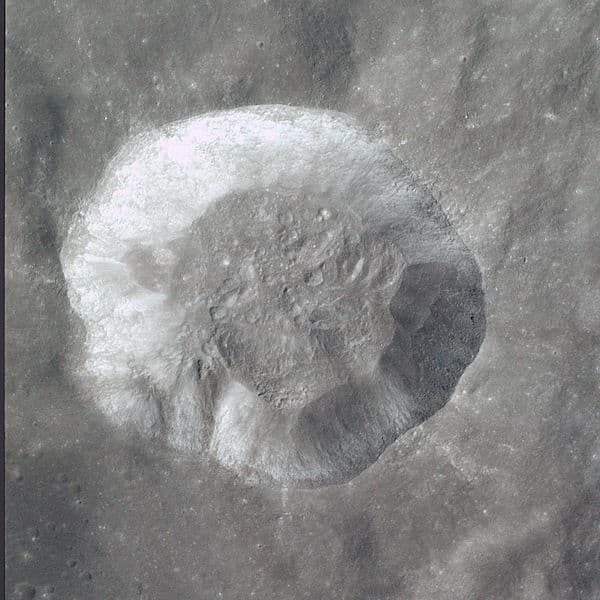
In 1935, the International Astronomical Union named a crater on the visible side of the Moon after Proclus.


